
Something DIFFerent~!
The New Vanquish MG Lola-T260
December 27, 2002
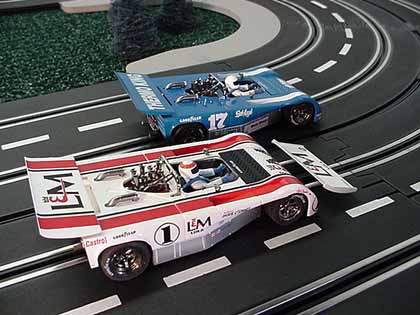 Let's
cut to the chase shall we? The big attraction of the recently announced line of
1/32nd scale models from newcomer Vanguish MG is the rear functional
differential, or rather WILL it function? Making large claims of increased
performance, along with a incredible level of detail, these cars have been the
buzz of the hobby for months.
Let's
cut to the chase shall we? The big attraction of the recently announced line of
1/32nd scale models from newcomer Vanguish MG is the rear functional
differential, or rather WILL it function? Making large claims of increased
performance, along with a incredible level of detail, these cars have been the
buzz of the hobby for months.
For this review, I did things a little differently. First off, I ran these cars longer and harder than the average model. I felt I should put as much wear and tear on these cars before coming to any conclusions. After all, these models are quite different than the usual cars we see here. These models have been out for a few weeks, and already reports have came in stating the rear differential failed. Grinding of the spur gear and no increase in performance are just a couple items worth mentioning. It did not look good for this upstart company.
Well, regardless of these reports, I ordered both the Lola T-260 models of Jackie Stewart and Bob Nagel and decided to see for myself. We tested these cars one at a time on 3 different track systems and with varying power supply and control. First, 400 laps were put on each car at 100 lap intervals on our small Artin oval, 200 in each direction alternating direction after every run. Then we ran 300 laps on a T-2 Scalextric Sport configuration, and finally another 300 using Carrera track in the Checkered Flag Challenge design.
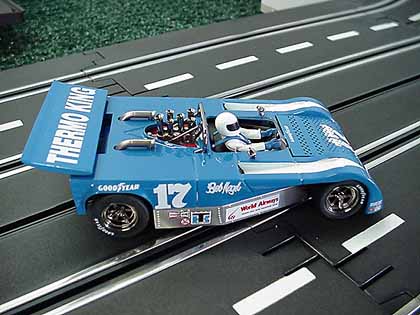
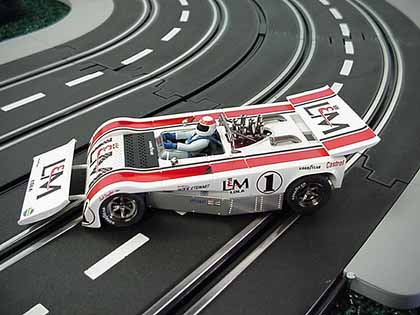
What else can I say...they are still running. The first laps produced a high pitched squeal, but after some lubricant added to the inside gears, this quieted down a great deal. Is this to say the differential WORKS? No. It simply means on our average home racing uses, and during our testing, they are still intact. Things could change however, and I could walk downstairs right now and pull the trigger, and hear the tell-tale sounds of a stripped gear, but so far so good.
However, I want to point out that I have had "normal" Fly cars fail with MUCH less testing. And compared to the grinding noises and gear squealing I have heard over the years from other models, these new cars seem to be above average after break-in. The difference is that if a "regular" car fails, there are companies that produce after-market upgrades that snap in for direct replacement, or you can simply purchase the stock components. Confirmation from VMG has indicated spares have been shipped for the rear assembly, and Slot Car World has some on hand now.
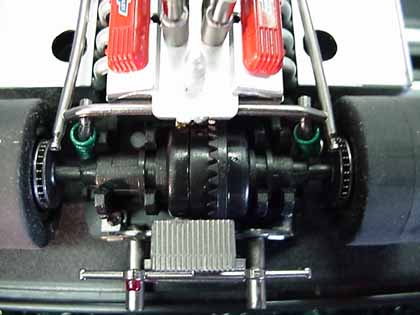
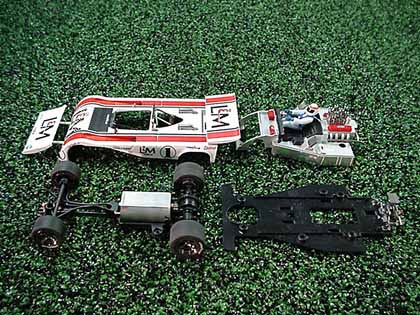
I won't start offering too many fixes or repairs as it is too early for me to make any real conclusions. I can highly advise becoming a regular visitor to forums such as Slot Car Illustrated and Old Weird Herald for upgrades and modifications for this model. The internet is a valuable tool if used correctly. Odds are the internet is why you even know about these models, and obviously what brought you here, so use it to your advantage. I will however offer 2 tips that seem to have worked very well. Remove the diff assembly by using a small screwdriver and gently pry up on each side of the assembly. Don't try and remove it by hand from the center, as you will see the differential begin to split apart.
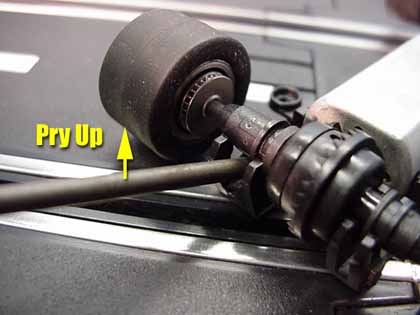
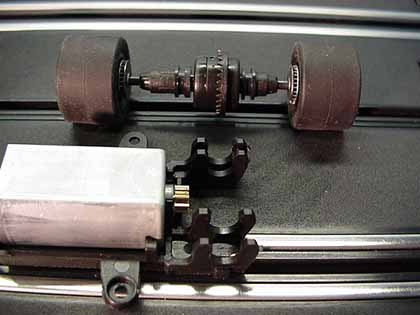
I took some silicone white grease in spray form (Wal-Mart brand here) and added a light coat inside this assembly. Now when you re-assemble the diff before installing it back into the chassis, add a VERY small drop of Super Glue on the seam of the differential, one drop on opposite ends as shown in the photo. This helped a GREAT deal in preventing the differential case from spreading apart, and causing these gears not to mesh correctly. I noticed that during testing, this area would work its way apart just slightly, but slightly is just enough to cause problems. Adding a little glue stopped this, and can still be easily removed later by using the edge of your Exacto knife and breaking the glue bond.
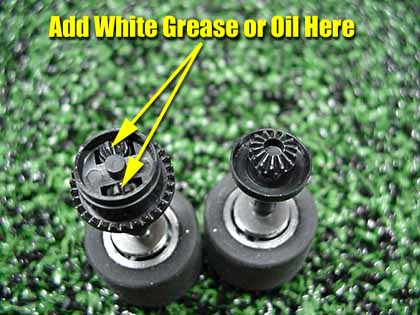
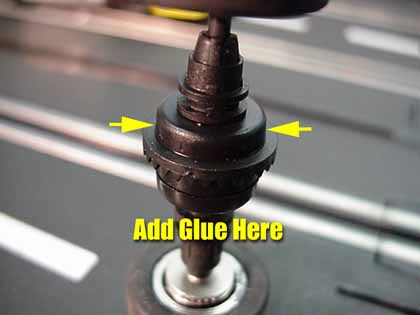
Now for the rest of the car! You have seen the photos by now of the detail included on these models, and I have to say they did an outstanding job according to my eyes. In fact, this detail was employed on this model better than the recent Fly 917/10 reviewed here. Underneath the sheet metal, they have included a full interior in a one piece, EASY to remove pan. This was much easier to remove compared to the 917/10, and although it does add weight into the performance equation, I still have to give VMG a thumbs up on its design. The fit of the body to the chassis detail was also well done with clean, even lines and no gaps present.
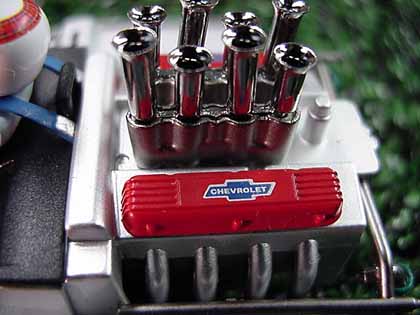
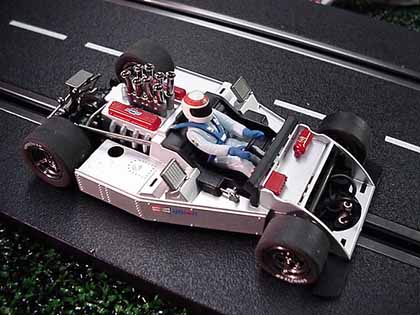
Detail is very well done, from the Chevrolet logos on the valve covers to real metal springs used for the rear suspension. One note, the top assemblies on the engine can come loose after running, so check these first and if they are loose, remove them by pulling up a little, then add some super glue or your favorite adhesive to the bottom ends and re-install them. Small details like Jackie's helmet colors were nice, with seat belts and gauges being very well done.
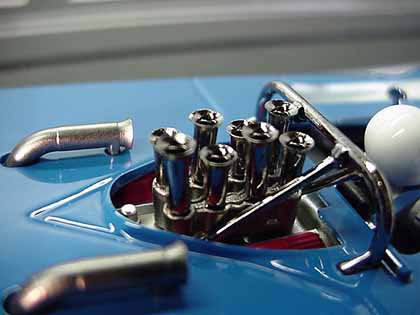
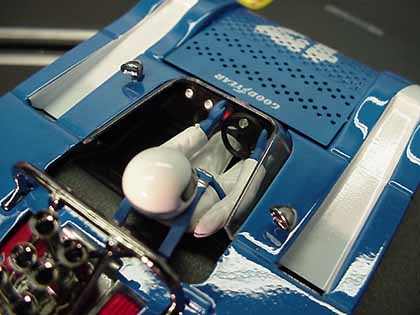
The car comes packaged in somewhat a familiar case, with the writing on the front being identical to Fly. Though VMG added their own Logo on the case, and directions for body and chassis removal underneath. A small screw used for shipping needs removal, then pull up on the clip-lock and she is free. Both models arrived intact with no broken parts or scratches.
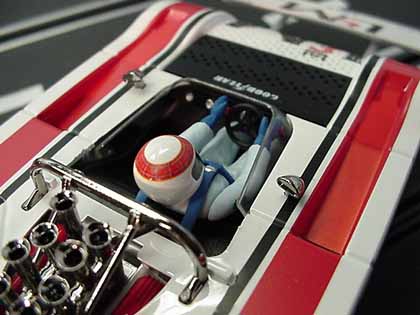
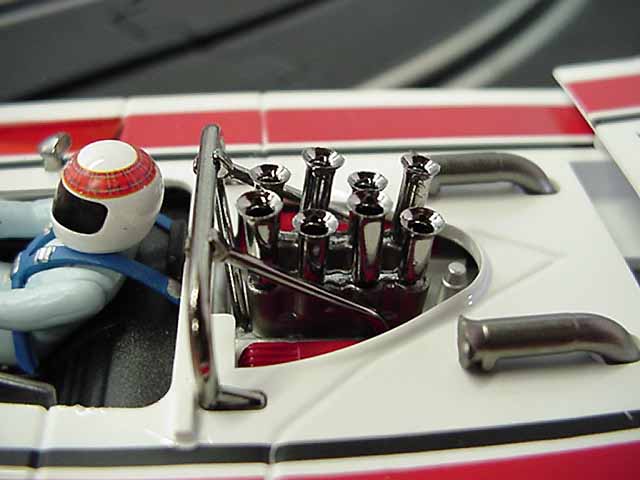
Fit and finish on these models were very well done. A few issues were noticed, but for their first effort as a new company I think they are headed in the right direction. Some paint issues were found on both models, the red stripes on Jackie's car didn't fill into the top seams, and the white stripe on the left front of the Bob Nagel car had some orange peel effect.
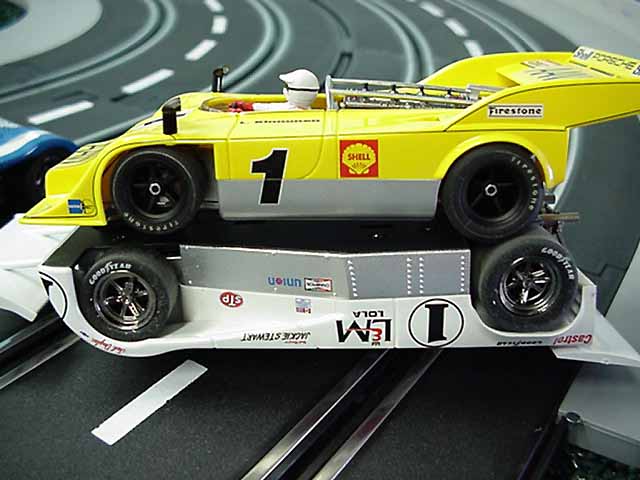
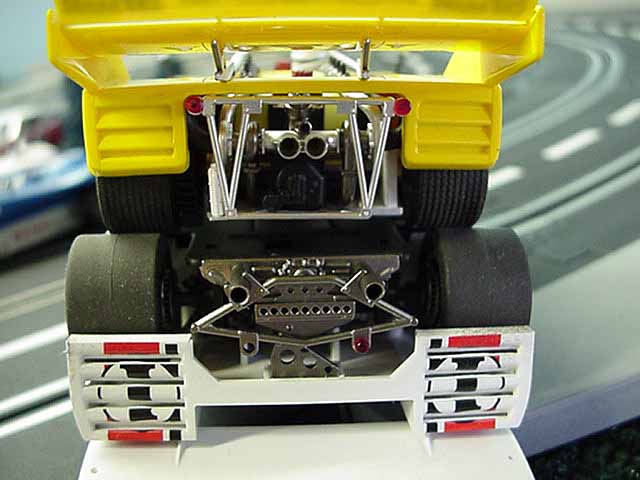
Some slight excess flash molding was found on both of the rear wings on the outside, and one paint run was found on the Nagel model rear wing. The question is: Is it to SCALE? Some have mentioned this car is too large for 1/32nd scale. I compared this car to the Fly 917/10 for an example and you can see the difference. I don't have the time it would take to do the math...so perhaps a reader can help with this? The rest of the Tampo-stampings were very well done, with no signs on runs or color fades, and I was happy to find an even, dust free clear-coat.
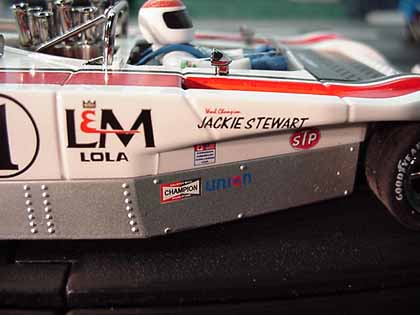
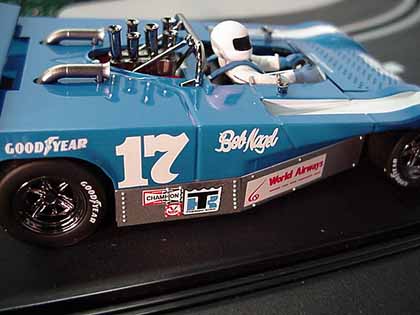
Wheels and tires were nicely done, with all the tires being very round and true. A solid front axle snaps in place and has some side to side free play. Sadly, on both my models, this free-play can cause the front tires to rub on the body. I took a Dremel Moto-Tool, and using a cut-off wheel, trimmed the axle as shown in the photo on one end. I re-installed the front wheel and it was a snug fit, and backing it off a half-turn freed it up nicely.
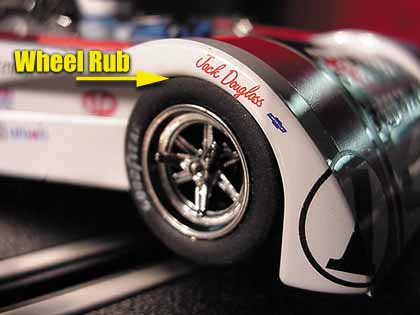
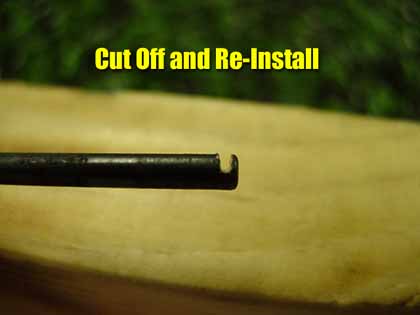
The wheels are full chrome with a nice finish, although prototype photos indicate almost a black finish on the inside spokes and more of a polished aluminum look. A mold line down the center of the tires will quickly disappear during your initial runs, however I sand all my tires, and this was cured immediately. Again the question whether these wheels and tires are to scale are yet to be answered, however these new models seem to have captured the actual look of the prototype very well. The tires provide decent grip after sanding, and I most likely will stick with the original rubber even if after-market silicones are made available.
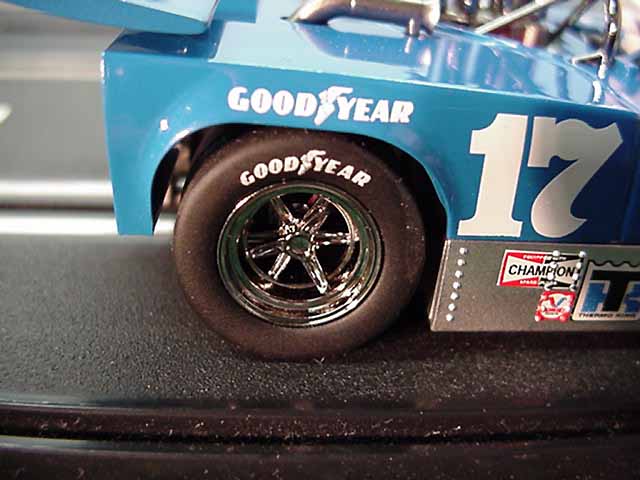
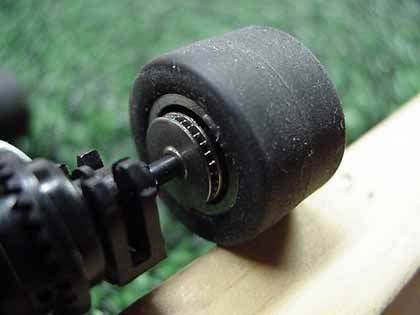
The chassis itself is broken down in 2 parts after you remove the 4 screws mounting the body, and then the 2 screws for the interior assembly. The main chassis assembly containing the inline-drive motor configuration, guide wiring and gearing simply snap out of the bottom chassis plate at the rear. The guide seemed a little loose, but has held in place through some tough tumbles.
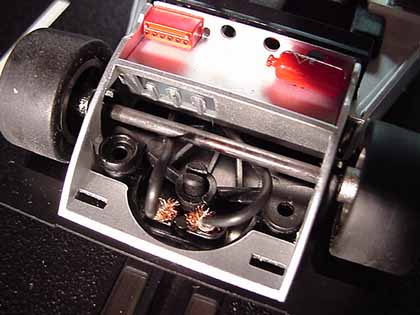
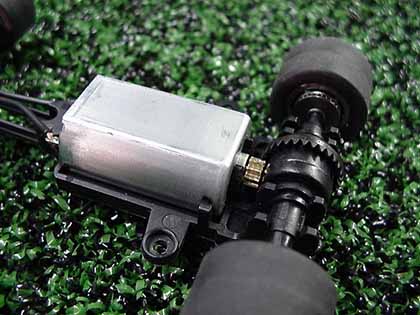
The front wires might rub the front axle, if yours does, a small piece of tape across the front brace prevents this. The power plant here looks and acts identically to the motors found in the Fly Trucks. I don't have confirmation on the stated rpms, but at least physically, it is the same as these and the Ninco NC-2/3. A button magnet is placed just forward of the motor and is identical to the Fly B21 standard magnet found in many of the sidewinder B34 rear pod assemblies. This chassis is very flexible indeed, and removal of the body and then placing the car on the track will result in the magnet bending the chassis and it will drag the rails. This happened on all brands of track tested. In its assembled form however I didn't notice any of this flexing toward the track.
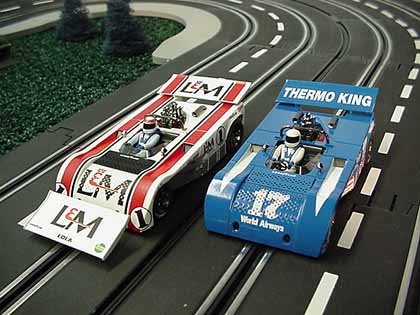 Driving
these cars have not only been a challenge, but a great deal of fun as well. The
magnet is a fair distance away from the rails, and in its mid-position location
provides light magnetic down-force allowing a more forgiving drive in case your
heavy handed on the throttle. Braking was crisp and acceleration, as expected
with this motor, was strong and clean. Sliding these cars around the corners
didn't seem any different than other models, which means it was just as fun.
Driving
these cars have not only been a challenge, but a great deal of fun as well. The
magnet is a fair distance away from the rails, and in its mid-position location
provides light magnetic down-force allowing a more forgiving drive in case your
heavy handed on the throttle. Braking was crisp and acceleration, as expected
with this motor, was strong and clean. Sliding these cars around the corners
didn't seem any different than other models, which means it was just as fun.
So should you buy one? I can only tell you that I am happy with my purchase thus far. These models provided something different for a change, and it was refreshing at least. There are going to be some "kinks" that need worked out, this is obvious, but not as much as I actually expected, and I have purchased plenty of cars in the past that needed a few modifications to run efficiently. These models, at least in my humble opinion, are for the advanced enthusiast. Under the display case stand it states it isn't a toy...perhaps they are right. If your looking for something different, you might want to give these models a try. I know that the future releases will find a home here. You will never really know for sure until YOU try them.
Harry
As always, feel free to email me at wiseone@yhti.net about this article or just the hobby in general.
Or better still, drop into the Home Racing World Message Forum and let us know your thoughts.
A thanks goes to Slot Car World for providing me with these models. They have these in stock, with more on the way..